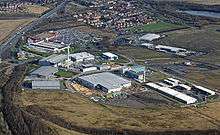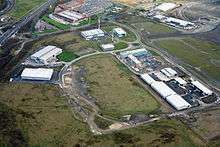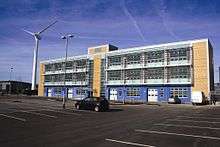Advanced Manufacturing Park
Coordinates: 53°23′06″N 1°22′44″W / 53.385°N 1.379°W

The Advanced Manufacturing Park (AMP)[1] is a 100-acre (0.40 km2) manufacturing technology park in Rotherham, South Yorkshire. It is part of Sheffield City Region Enterprise Zone.[2] Technologies on the AMP centre on materials and structures, covering metallic and composite materials, typically used in precision industries including; aerospace, automotive, sport, environmental, nuclear, and energy, oil and gas, defence and construction. Technology developed on the AMP is already being utilised in leading edge projects, such as within Formula One and the next generation of military and commercial aircraft, including the new Boeing 787 Dreamliner as well as advanced 3D printed facial prosthetics.
Organisations currently located on the AMP include; Nuclear AMRC, The Advanced Manufacturing Research Centre (AMRC), a Boeing / University of Sheffield partnership; Rolls-Royce; Castings Technology International (Cti); Sandvik Coromant, Bromley Technologies, Nikken Kosakusho Europe Limited, Fripp Design and Research, Performance Engineered Solutions (PES), Materialise, Struers, Xeros, and TWI Technology Centre (Yorkshire). A full list of companies currently based at the AMP can be found here.
The vision for the AMP emerged from the decline that South Yorkshire had seen in its traditional industries of coal and steel over the last twenty years. Despite this decline the region had retained established skills and expertise in the areas of advanced manufacturing, backed by materials research expertise within the two Sheffield universities, and other independent research organisations. Yorkshire Forward and UK Coal created a joint venture to reclaim land on the former opencast colliery at Waverley, Rotherham and to develop the AMP. Funding from the European Union's European Regional Development Fund have also supported the project.
Development history
2017
McLaren Automotive announced the opening of a £50m manufacturing plant that will create more than 200 jobs. The McLaren composites technology centre will build carbon-fibre chassis for future McLaren sports cars. Full production will begin at the AMP by 2020.
2016
The director of Nuclear AMRC stated that its facilities, which had cost £40 million to date, would not be used in anticipated new nuclear builds as the foreign financiers had an interest in using their own country's existing supply chains. He stated the facility was "a sleeping giant" and argued that forthcoming small modular reactor designs could be built at the facility with government support.[3]
2016 saw the official opening of a new 32,000 sq ft facility which comprised the third phase of the AMP Technology Centre. The building, funded by the Homes and Communities Agency (HCA), includes specialist office and workshop spaces. The purpose of the facility is to provide companies the opportunity to expand into larger premises from existing Technology Centre facilities as well as attracting high technology companies from further afield.
2014
The University of Sheffield Advanced Manufacturing Research Centre (AMRC) with Boeing signed a deal to secure land at Sheffield Business Park, paving the way for the further expansion of the AMRC which could not be accommodated on the AMP site. The first development at the new location, sited directly opposite the existing AMPs developments on the other side of the Parkway, was announced as the AMRC Factory 2050. This £43 million project will develop the UK's first fully reconfigurable assembly and component manufacturing facility for collaborative research, capable of rapidly switching production between different high-value components and one-off parts.[4]
In March 2014 Rotherham Council announced a £4.3 million deal that will enable development to begin at the R-evolution @ The AMP scheme. Landowner and developer, Harworth Estates had previously announced plans to develop 100,000 sq ft of industrial units on seven acres of land, following on from the success of the Evolution @ the AMP development built in 2008.[5]
2013
The year saw construction of two major new facilities for the AMRC.
Firstly, The AMRC Training Centre, based in a new 5,500 sq m building aimed to provide the next generation of world leading engineers. The Centre took in its first intake of students in autumn 2013 with partial funding from a £9.2 million Regional Growth Fund grant.[6]
It provides tailored courses of practical and academic skills, from apprenticeship through to doctorate and MBA level, plus continuing professional development. About 250 people will enter each year for advanced apprentice training, with support from their employers. It will primarily serve businesses with operations in the region – including Rolls-Royce.
Secondly, the original AMRC building underwent significant redevelopment and expansion to create a new Design Prototype and Test Centre (DPTC) specialising in aerospace and high performance applications of design. The extended building was set to employ around 40 exceptional design engineers plus support staff. Existing testing equipment in the building was complemented by new rapid prototyping and structural testing facilities, to create a manufacturing design resource capability far beyond anything currently available in the UK.
In February 2013, Harworth Estates announced that it had sold the 'Evolution @ the AMP' development of light industrial / hybrid units to Cornerstone, the real estate advisory and investment company, for £7 million. Later in the year Harworth announced its intention to construct a second, similar development to be named 'R-evolution @ the AMP'.
During the summer of 2013 The University of Sheffield Advanced Manufacturing Research Centre (AMRC) announced its acquisition of Castings Technology International (Cti). As part of the agreement, the staff, buildings and assets of Cti and Titanium Castings UK Ltd (TCUK), including the ongoing research work, commercial contracts and consultancy were transferred to become a University of Sheffield subsidiary company.
2012
Harworth Estates exchanged contracts with Rolls-Royce plc on 17.4 acres of land at the Advanced Manufacturing Park (AMP), Waverley, Rotherham, South Yorkshire. This site was within the area of the Sheffield City Region Enterprise Zone.
Work began on building the first of these facilities, the new Rolls-Royce Advanced Blade Casting Facility (ABCF). The Advanced Blade Casting Facility been expected to produce its first blades in late 2014, with the facility capable of manufacturing 200,000 blades per year when fully operational. Each blade will be cast to form a single crystal of super alloy, making it extremely strong and able to resist the intense heat inside a jet engine. The 14,000 m2 facility would be one of the most advanced blade casting facilities in the world, featuring groundbreaking manufacturing techniques such as 3D structured light for geometry inspection.
An official groundbreaking ceremony took place to mark the start of construction on the ABCF in June 2012, with the Business Secretary Dr Vince Cable and Rolls-Royce's Colin Smith, Director of Engineering and Technology performing the honours with some of Rolls-Royce's apprentices.
The second proposed Rolls-Royce facility known as "Project PoWeR", was planned to manufacture and assemble large pressure vessels for the next generation of nuclear power stations. This included a 21,000 SqM (226,000 SqFt) factory building that would be around 33 metres at its highest area, and able to accommodate the production of vessels that will weigh 140 tonnes and stand 23 metres high. Construction was scheduled to begin in late 2012, with the first of the pressure vessels constructed in 2015, but uncertainty within the UK civil nuclear power programme has caused Rolls-Royce to suspend their plans for this project.
Harworth Estates also agreed contracts with Taylor Wimpey, Harron Homes and Barratt Homes to build new homes on their Waverley site marking the first phase of residential development. The house builders acquired a total of 20 acres for an initial 254 homes, and work on the infrastructure and spine road access to the housing site started in spring 2012. The first houses were offered for sale following a launch event with England 1966 football hero Gordon Banks in September 2012 and the first families had moved into their new homes by Christmas 2012.
This development is the first phase of the sustainable new community consisting of nearly 4000 new homes and community facilities expected to be built over the next 20 years, and including schools, medical centres, retail and leisure facilities.
2011
Late 2011 saw the completion of the Nuclear AMRC building and a new low-carbon landmark for both the AMRC and the AMP as a whole. Installation was completed of a 99-metre wind turbine with a rated power output of 900 kW. Onshore wind turbines in the UK typically operate at an average of 25% of the rated output, so the Nuclear AMRC’s turbine should generate an average of over 5000 kWh per day, equivalent to the electricity used by 500 households.
2010
The AMP became home to the new £25 million Nuclear Advanced Manufacturing Research Centre (Nuclear AMRC) led by the University of Sheffield with Rolls-Royce, funded with £15 million from the Department for Business, Innovation and Skills and £10 million from the regional development agency Yorkshire Forward.[7] The Nuclear AMRC is a joint initiative with industry, The University of Sheffield and The University of Manchester’s Dalton Nuclear Institute. The consortium forms part of the Government’s Low Carbon Industrial Strategy and is at the forefront of enhancing manufacturing capability by assisting members to increase quality, reliability and efficiency and reducing costs and complexity. It is expected to draw together some 30 partner high-tech manufacturing suppliers who are committed to meeting UK demand and playing a significant part in global markets through the production of high-value, low-volume systems and components in a competitive manner.
2009
Construction completed on a 40,000 sq ft (3,700 m2). building adjacent to the existing Castings Technology International (Cti) headquarters building. The £4.7 million project increases Cti’s presence on the AMP to over 90,000 sq ft (8,400 m2). The new facility will house additional R&D equipment, production-scale ‘technology demonstrators' and a major investment in state-of-the-art equipment to finish, inspect and certify castings to the highest integrity standards required by industrial clients.
Dormer Tools located to the AMP as part of the Evolution @ the AMP development of light industrial units. New investments and opportunities at Dormer's Product Development Centre and Composite Competence Centre at the AMP will provide a strong foundation for future development activities of High Performance Drilling and Specialist Applications. The Research and Development Centre has the ability to provide greater understanding of drilling and its dynamics. The investments include the building of a state-of-the-art research and development laboratory, with the purchase of a number of DMG machines for testing of new product developments in metal and composite drilling.
2008

The Rolls-Royce "Factory of the Future with Boeing" was built as part of the University of Sheffield's Advanced Manufacturing Research Centre (AMRC). The Factory is purpose built to house the latest manufacturing equipment and production capabilities. Information Communications Technology (ICT) and 'virtual' manufacturing will be key components of the new facility, as will alternative manufacturing methods, such as additive manufacturing processes which grow 3-dimensional parts; considerably reducing material waste and increasing design flexibility. Construction was completed by the end of 2007, and the facility officially opened in summer 2008.
The AMRC also expanded outside of its traditional expertise in metallic-based materials, into the increasingly important area of composites. The AMRC Composite Centre is a research, design, manufacturing and technology transfer centre for composites developed for general manufacturing and aerospace applications. The increase in the importance of composites is shown by the fact that 50% (by volume) of Boeing's new 787 Dreamliner will be constructed in composite materials.
The extension to the AMP Technology Centre was opened which includes a 56m three blade wind turbine, visible from the M1 motorway around Junction 33.
2006
Yorkshire Forward complete the construction of the main wing of the AMP Technology Centre, 27,000 sq ft (2,500 m2) of offices and workshops to cater for small high-growth companies in the Advanced Manufacturing and Materials sector.
2005
Castings Technology International construct a 50,000 sq ft (4,600 m2) building. This research and technology, member-based organisation has expertise in casting design, materials development and selection, specifications, manufacturing technologies, quality control, testing and performance. Cti have a global membership base.
TWI build a 20,000 sq ft (1,900 m2) Yorkshire Technology Centre - R&D centre for Fibre Laser Processing, Friction Stir Welding, Laser Direct Metal Deposition, Cold Spraying. The building houses one of the largest friction stir welding machines in the world with over 130 KW of spindle power. The machine has 12 programmable machine axes, a maximum down force of 15 tonnes and operates over an area of 6m x 3m.
2004
The University of Sheffield Advanced Manufacturing Research Centre (AMRC) with Boeing moved onto the AMP.
Roads on the AMP
All the roads on the AMP are named after famous engineers. These include
Brindley Way - James Brindley: Master canal engineer, and one of the most notable engineers of the 18th century. Brunel Way - Isambard Kingdom Brunel: Considered "one of the most ingenious and prolific figures in engineering history" Mitchell Way - R.J. Mitchell: Aeronautical engineer, who designed many aircraft including the iconic Supermarine Spitfire. Morse Way - Stephen Morse: Inventor of the twist drill Stephenson Way - Robert Stephenson: Designer of The Rocket locomotive in 1829. Wallis Way - Barnes Wallis: Scientist, engineer and inventor, best known for inventing the bouncing bomb used by The Dam Busters. Whittle Way - Frank Whittle: Inventor of the turbojet engine.
UK's First Hydrogen Powered Building

In 2006, the regional development agency, Yorkshire Forward, opened an innovation technology centre providing small office and workshop space for new and growing manufacturing technology companies. Late 2008 saw the completion of an extension to the AMP Technology Centre, designed for companies developing new energy and environmental technologies. A unique feature of the building was a sophisticated energy system, developed by TNEI Services Ltd. and the Pure Energy Centre, which both reduced the electricity demand of the operation of the building and the activities of its occupiers from the network and which will has the capacity to export electricity to the local electrical network.
Electricity can be generated from a 225 kW wind turbine at the edge of the site, attached to an electrolysis unit which can convert some of the wind energy into hydrogen. The hydrogen is then be stored in composite cylinders and fed to a 30 kW fuel cell when required to provide electricity to the building during the day and potentially supplying the National Grid with surplus power. The building is attached to traditional electricity supplies in case of an emergency but it is expected that this building will be fully self-sufficient.
It will also demonstrate Future Energy Concepts, some of which will focus on hydrogen production, storage and power generation, which will be actively used to manage the building demands and to make maximum use of the installed wind capacity. The hydrogen storage will provide a buffer to allow the facility to continue generating power in low-wind conditions and to provide an on-site electricity consumer for excess power generation when building occupancy is low (i.e. overnight and weekends).
The building itself has very low energy emissions. It is heated by a network of pipes set into the concrete, supplied by water from bore holes heated naturally to 28 °C. In the summer the water remains at its normal 12 °C, cooling the building.
In 2013 it was announced that the management and further development of the hydrogen mini-grid system would be undertaken by Sheffield-based ITM Energy through a contract with the Government's Homes & Communities Agency (HCA).
References
- ↑ http://www.attheamp.com
- ↑ Tingle, Len (12 August 2011). "Can enterprise zones do the job this time around?". BBC News Online. Retrieved 12 March 2015.
- ↑ Kiran Stacey (16 February 2016). "UK nuclear expertise wasted by delays and developer choices". Financial Times. Retrieved 17 February 2016.
- ↑ http://www.rothbiz.co.uk/2014/02/news-3924-amrc-submit-plans-for-factory.html
- ↑ http://www.rothbiz.co.uk/2014/03/news-3989-rotherham-council-concludes.html
- ↑ http://www.rothbiz.co.uk/2013/09/news-3637-amrc-training-centre-opens.html
- ↑ "Lord Mandelson announces £25 Million Nuclear Advanced Manufacturing Research Centre". Advanced Manufacturing Research Centre. 3 December 2009. Retrieved 17 February 2016.
External links
![]() Media related to Advanced Manufacturing Park at Wikimedia Commons
Media related to Advanced Manufacturing Park at Wikimedia Commons
- Advanced Manufacturing Park (AMP)
- Rolls-Royce Civil Aerospace
- Advanced Manufacturing Research Centre (AMRC)
- Nuclear AMRC
- AMRC Training